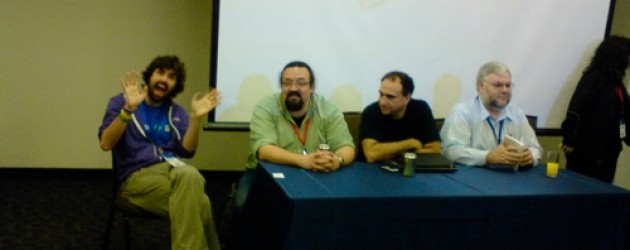If you haven’t heard the news. Google’s not just for searching anymore. It’s got a lot more going on, like maps, Youtube, an online library, a new browser of its own, a rival to the iPhone store, and 16 million lines of open source code in four years. So how does the new Google see itself?
“If you’re asking for a mission statement, here it is,” replied Chris Dibona, Director of Open Source Code at Google World Headquarters. “We want to harness the world’s information and make it useful.”
Such was the atmosphere among computer folk at last week’s Google Development Day (GDD), held at Airport City. There were seminars and talks on how to use the tools Google has developed (or acquired and made their own) for the organization, digestion, and presentation of that information.
The computing society is moving on-line, converging from three directions – print, television, and computer media. Print’s problems are well-known, with the long-term erosion of its audience (due to the internet and poor worldwide reading standards). As far as television is concerned, that. too is showing its first signs of cracking under the strain of competition with the Web: In last week’s election, pollsters found that more of the 18-31 set got their information about Barack Obama and John McCain from the internet than from TV. And media, such as disks, CDs, and even DVDs, have long been losing out to on-line storage, digital MP3 music and video files, etc.
So it’s not just information that Google is organizing: It’s online electronic information, which Google hopes will become the medium for storage and transfer of most forms of information, like books,
video, documents, databases, etc. Naturally, the company develops tools to allow developers and users to manipulate that information.
But Google can’t be everywhere all the time; it can’t provide all the information it would like to in all possible forms. But it can help developers do so – and in order to make things easier for them, Google provides numerous APIs which they can plug into the applications or services they are building, many with minimal programming required; much of the “heavy” programming work is done on the Google back end, so if you don’t need to modify the default API too much, you won’t have to dedicate too much effort to integrating it into your product. Thus does Google win hearts and minds in the developer community – by making available to them easy to use and integrate components that make their lives easier, all for free!
Google sponsors its Developer Days in 16 countries around the world – including Israel, which has, according to the Google folk at the fair, one of the larger GDDs, thanks to the large number of internet application and service companies here. The truth is, lots of these companies would probably use the Google API as components in their applications anyway, because they’re there, easy to use, and free. So, it’s awfully nice of Google to put on a nice party, complete with snacks and lunch – thus promoting good public relations, as the company realizes that the true way to the heart of internet programmers is through their stomachs.
And, according to the company execs who presented at a press conference during the program, Google is always innovating, looking for the new products to roll out to developers. “Seventy percent of Google’s work is in the search engine and applications, 20A% is in emerging products – where we come up with major new ideas that eventually go ‘mainstream,’ like Google Docs – and 10% is what we call the ‘crazy’ stuff, which may or may not ever get out of the lab,” Dibona said.
Google’s two newest projects – Chrome and Android – were much on the mind of Google staffers. Chrome (http://www.google.com/chrome), of course, is the new browser the company has released, with Google hoping to garner market share from Internet Explorer and Firefox users. Why bother with a browser? According to Bill Hesse, who works on Chrome, the company wanted “a faster browser with fewer buttons and more space on the screen for display, as well as being more compatible with increasingly complex Google applications.” The browser is completely open source, and according to http://tinyurl.com/5zzz9q, Chrome doesn’t collect information about your online activity, and doesn’t even hardcode its own search engine into the browser (unlike IE, where, if you leave MSN as the default page, you can’t even touch the screen until the MSN site loads).
Android is an even more ambitious project – an operating system and software platform for mobile phones, also open source, free, and completely flexible for development purposes. The phones themselves are made and offered by cell phone manufacturers and service providers (especially T-Mobile in the U.S.), and cost roughly the same as other smart phone; the idea is to let developers run wild, taking advantage of all the features of both phones and Android code, letting them come up with the next “killer app.”
Naturally, the Google Israel people had what to say as well. Yossi Matias, head of Google’s Tel Aviv development center, and Yoelle Mark, head of the company’s Haifa development center, discussed the Israeli contribution to Google worldwide. Far from just rendering Gmail and Google Maps into Hebrew (and a fine job they did on both), Israel is also the main development center for several Google products, such as Trends (http://www.google.com/trends), Youtube annotations (http://www.youtube.com/t/annotations_about), and Youtube contests (http://www.youtube.com/contests_main). Thus Israel, too, pulls its weight in the Global Google Information Empire. And we couldn’t be happier!

![Reblog this post [with Zemanta]](http://img.zemanta.com/reblog_e.png?x-id=f7fcbeb0-c28a-4743-b741-197c4c926a47)
